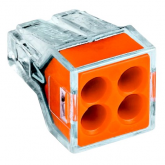John Frum
Tell me your problems
- Joined
- Nov 30, 2019
- Messages
- 15,233
I just got some Wago 221-613 and 221-413 lever nuts for evaluation.
Its my understanding that they are popular in Europe but are just starting to gain traction in North America for AC applications.
The big ones accept up to 10 awg stranded without a ferrule.
They also accept 12/14/16 awg with or without a ferrule.
The small ones accept 12/14 awg without a ferrule and 16 awg with or without a ferrule.
I think they should be fine for vibration tolerance.
I see them as quite a useful option for stationary and mobile DC applications as well as AC.
I will leave the marine application suitability question to somebody more qualified.
I can say that they don't appear to be water proof.




Its my understanding that they are popular in Europe but are just starting to gain traction in North America for AC applications.
The big ones accept up to 10 awg stranded without a ferrule.
They also accept 12/14/16 awg with or without a ferrule.
The small ones accept 12/14 awg without a ferrule and 16 awg with or without a ferrule.
I think they should be fine for vibration tolerance.
I see them as quite a useful option for stationary and mobile DC applications as well as AC.
I will leave the marine application suitability question to somebody more qualified.
I can say that they don't appear to be water proof.








